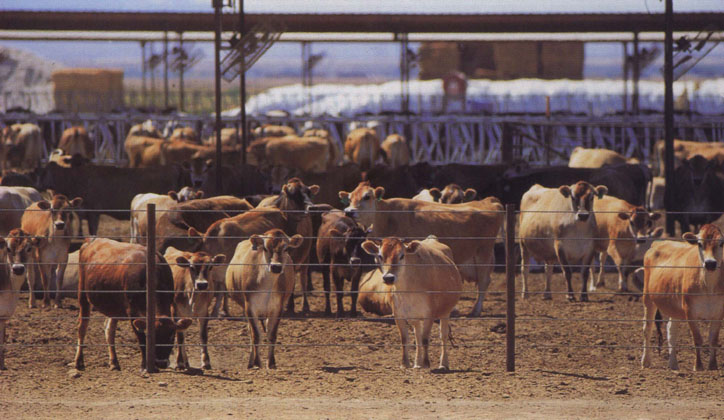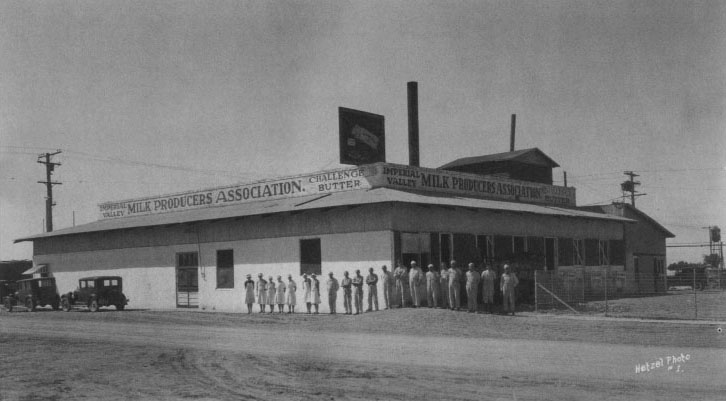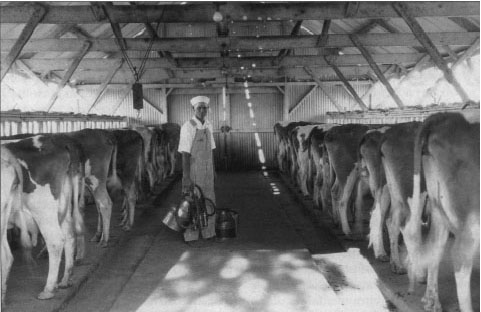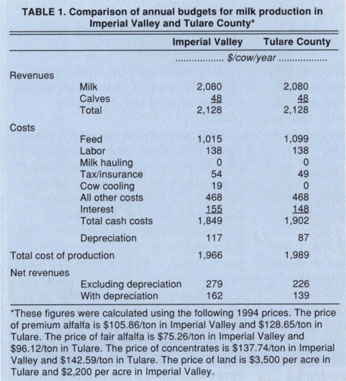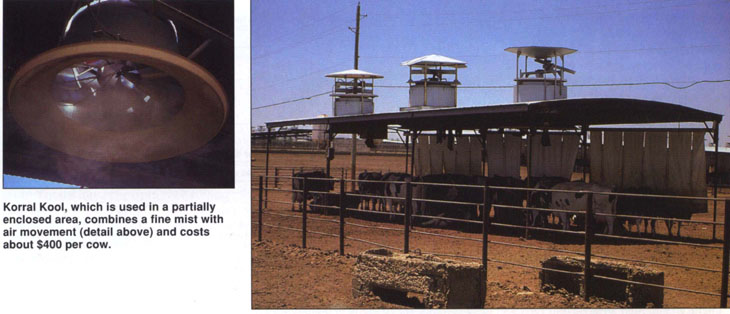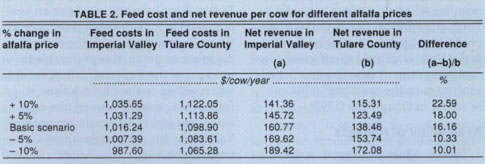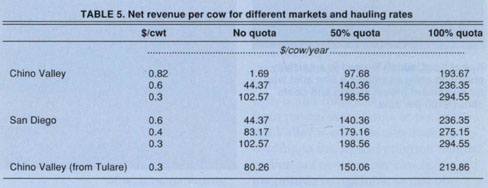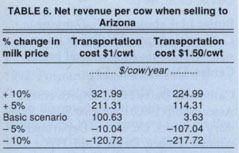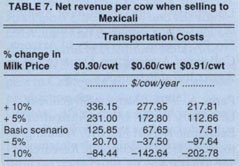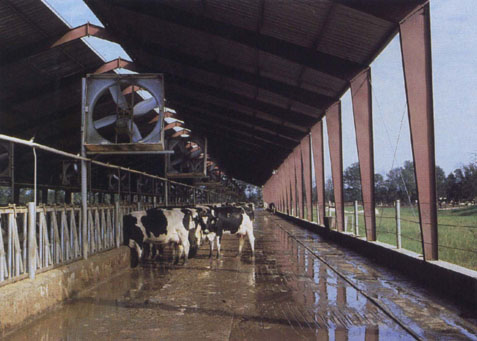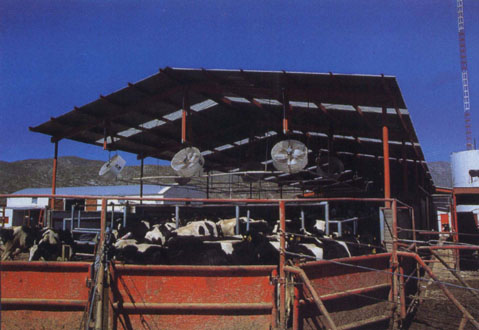All Issues
Appropriate market is key to success of dairying in Imperial Valley
Publication Information
California Agriculture 51(3):17-24. https://doi.org/10.3733/ca.v051n03p17
Published May 01, 1997
PDF | Citation | Permissions
Abstract
Growth and development pressures and environmental regulations are forcing dairy enterprises in the Chino Valley to relocate. Alternative areas for producing raw milk for the Los Angeles–San Diego basin will be needed. Two areas of particular interest are the Imperial and Palo Verde valleys. For the scenario studied, milk can be produced in the Imperial Valley at least as efficiently and cheaply as in the southern San Joaquin Valley. Transportation costs will determine profitability. Establishing a viable dairy industry in the Imperial Valley will also depend on the size of herds, the establishment of milk processing plants and the regulatory environment that surrounds it.
Full text
Keeping cows cool to alleviate some of the effects of heat stress is imperative to dairying in the desert.
Of the 30 million people living in California, two-thirds live south of the Tehachapi Mountains, in an area commonly referred to as the Los Angeles-San Diego Basin. Most of the milk requirements of those 20 million people are met by milk produced in the Chino Valley, to the east of Los Angeles. However, growth and development pressures and environmental regulations are forcing dairy enterprises in the Chino Valley to relocate. The shift of this major supply of raw milk away from the immediate vicinity raises the question of who will supply the Los Angeles–San Diego basin with raw milk.
It is expected that the southern San Joaquin Valley (SJV) will become the major source of raw milk for the Los Angeles metropolitan area, since it already supplies about 20 to 25% of Southern California's raw milk requirements. However, as the number of cows in the southern SJV increases, land suitable for large dairy operations there is becoming more expensive and difficult to establish. Waste management is also becoming a major problem, forcing the imposition of tighter regulations. It is probable, therefore, that alternative areas for supplying raw milk to the Los Angeles–San Diego basin will need to be examined.
Two such areas of particular interest are the Imperial and Palo Verde valleys, located in Imperial and Riverside Counties. Since most of the alfalfa hay supplied to the Chino Valley dairy industry currently originates in Imperial County, and given its proximity to new and growing markets in Mexico as a result of the North American Free Trade Agreement, it is possible that relocation to the Imperial Valley is at least as feasible as moving to the southern SJV.
Dairying was a thriving industry in the Imperial Valley 50 years ago. In 1944, there were 954 dairy farms in Imperial County.
Dairying is not new to the Imperial Valley (Anderholt, 1990). In 1944, there were 954 dairy farms in Imperial County, of which 223 were commercial dairies accounting for almost 10,000 cows. As recently as 1970, there was a significant dairy industry in Imperial County. However, with the establishment of plants in the Los Angeles area in the late 1960s and the closing of the last plant in Imperial County in 1964, economic conditions forced many to relocate to the Chino Valley and San Jacinto/Hemet area. Today, only two dairies are in operation in the Imperial Valley, milking a total of 2,000 cows.
This study examines the feasibility of dairying in the Imperial and Palo Verde valleys and the economic viability of available markets. It is assumed that conditions in the Palo Verde Valley are similar to those in the Imperial Valley; references to the Imperial Valley in this study therefore apply to the Palo Verde Valley as well.
Imperial Valley climate
While some see the Imperial Valley as an alternative location to the southern SJV, others question whether it is physically possible to produce milk in the Imperial Valley's climatic conditions. The Imperial Valley lies at the southern end of California next to the Mexican border. Although temperatures are relatively mild during most of the year, summer temperatures can be very high. The mean annual temperature is 72°F, and the average maximum temperature is 115°F. On summer nights, maximum humidity can reach 75%, while the minimum humidity sometimes exceeds 40%. Research has shown that any combination of temperature above 86°F and relative humidity above zero results in mild to severe heat stress for dairy cattle. Heat stress in lactating cows can cause economic losses in two ways. The immediate impact is a decrease in milk production; the long-term impact is impaired reproduction performance. Armstrong (1994a) reported losses of up to 30% in milk production and 50% in reproductive efficiency in warm or hot climates without some modification to the environment of the animal.
If costs are not considered, it is always possible to find a technology that will make production possible under extreme climatic conditions. Although the technology to produce significant amounts of milk in extreme climates is available, it remains to be answered whether a dairy farm in the Imperial Valley would be economically viable.
Economic feasibility
The following analysis addresses two basic considerations: whether it is economically feasible to produce milk in the Imperial Valley, and whether markets are available for the milk that is produced.
In the framework of this study, a dairy in the Imperial Valley is defined as economically feasible if it meets two conditions: 1) net revenue per cow is positive, and 2) net revenue per cow equals or exceeds that obtained in the southern SJV. The first condition addresses the issue of whether a dairy can survive and expand while doing business in the Imperial Valley. The second considers whether the Imperial Valley can be as attractive as the southern SJV for dairy producers moving out of the Chino Valley.
To answer these questions, we compare two hypothetical dairy farms — one in the Imperial Valley and the other in the southern SJV. The idea is to make realistic assumptions about the hypothetical dairies and use our knowledge of the differences between the two locations to construct detailed budgets that reflect the essential differences in investment requirements, costs, income and profitability between the two farms. These budgets are then subjected to a number of sensitivity analyses to determine how net revenues change as our assumptions are modified.
Basic scenario
Investment requirements
It is assumed that both dairies have 40 acres, the minimum amount of land required to handle the herd and milking installations. Land is valued at prices representative of each area: $3,500 per acre in Tulare County and $2,200 per acre in the Imperial Valley. These prices were obtained from local banks and real estate agents.
The assumption that 40 acres is sufficient land on which to establish a dairy is, of course, unrealistic. First, land suitable for dairying does not generally come in handy 40 acre lots. Second, in both the Imperial Valley and the southern SJV, additional land would be required for manure waste management. However, since any additional land would not be directly related to the dairy operation, it is assumed that the income generated by the additional land simply offsets the capital cost and taxes arising from ownership. We have no reason to believe that waste management costs would be different in the Imperial Valley than in the southern SJV. Therefore, they are assumed to be equal for both farms.
Both farms are assumed to have 1,000 cows, and prices of cows and replacements are assumed equal. They also have similar equipment investments, differing only in the cow-cooling equipment required to manage heat stress in the Imperial Valley. These are modern facilities equipped with a milking barn, covered holding corral and drylot corrals with feed manger, including slope and shade. Investment in physical capital, excluding land and cow-cooling equipment, is $1,561 per cow. Equipment prices were obtained from suppliers and consultants.
Composition of the capital stock and its disposition on the dairy follow the specifications of Armstrong (1994a)
Heat stress in the Imperial Valley can be extreme during the summer months. Over the past decade, however, successful dairy industries have been developed under similar conditions in Arizona and New Mexico (Perez, 1994). Technological improvements in cow cooling developed in the past 10 years can alleviate some or all of the detrimental effects of heat stress. Korral Kool, for example, is a primitive air conditioning system used within a partially enclosed barn. It combines a fine mist with air movement, all controlled by computers. Spray-and-fan is a less sophisticated approach involving a simple water spray and fanned air movement in an open, shaded area. This is used both in lounge barn areas and holding pens for cows at milking time.
Three investment alternatives are considered in the present study: 1) Korral Kool for high- and medium-production cows (60% of total) and spray-and-fan for low-production and dry cows (40% of total). This combination is used to construct the basic scenario. The economic data are based on Daugherty (1993). 2) Spray-and-fan for all cows. 3) No cooling.
Investment in spray-and-fan equipment costs $150 per cow. Korral Kool costs $400 per cow. Each system's efficiency in alleviating heat stress is reflected in specific responses in milk production and reproduction rates. Per-cow production responses for each cooling system and lactation stage are reported by Armstrong (1994b). Those results were used to construct annual weighted-average losses in milk yields.
Income and costs
Milk prices in California vary by region only when the dairy producer owns quota. The basic scenario assumes that farmers in each location possess no quota and, consequently, receive state Class 4 prices. A 5-year average of the Class 4 price was used in the basic scenario.
Cows in both locations produce 19,400 pounds of milk per year (DHIA, Tulare, 1993). The dairies also sell 480 calves per year. This assumes that the cow-cooling system in the Imperial Valley alleviates heat stress enough to allow cows to reach the same production level as in Tulare County. Experiences of dairies in Phoenix, Ariz., and Mexicali, Mexico, support this assumption.
Production costs in both locations are assumed to be equal except for feed, transportation, cow cooling, taxes, insurance, capital costs and depreciation. Taxes and insurance, capital costs and depreciation differ only because they are calculated as a proportion of total investment. Differences in total investment arise from higher land prices in Tulare County and cow-cooling requirements in the Imperial Valley.
Feed is the single, most important component of milk production costs, representing approximately 50% of the total. Minimum cost rations for five animal categories were calculated by linear programming with the program PCDairy (Bath, 1994). These proportions were used to combine the rations for each cow category to obtain weighted average rations for a representative cow in each location. These rations reflect local feed availability and prices.
Transportation costs are the other major influence on revenue. Actual transportation costs depend on a variety of factors, including the volume of milk produced in the area, frequency of haulings, existence of backhauls, and origin and destination of the milk. Because of the importance of transportation costs, they are not included in the basic scenario but are analyzed in a separate section.
Revenue analysis in the basic scenario
The basic scenario (table 1) shows that when transportation costs are not considered, net revenue per cow in the Imperial Valley is 12.5% higher than in Tulare County. Cheaper land, a larger variety of feed and a substantially lower price for alfalfa more than compensate for the additional investment required for cow cooling.
Net revenue per cow in the Imperial Valley is $160.77, whereas in Tulare County it is $138.46. Feed costs in the Imperial Valley are $82.66 less per cow per year than in Tulare County, while all other costs (including depreciation) are $60.35 higher per cow per year. Clearly, the difference in feed costs is large enough to compensate for the additional costs arising from the cow-cooling equipment. Feed costs in the Imperial Valley are approximately 52% of total costs, while in Tulare County their share is about 55%. The more expensive items in the Imperial Valley are cow-cooling operating costs ($18.86), larger depreciation ($30 more than in Tulare County), and higher interest cost on investment ($10.50). The more expensive land in Tulare County is offset by higher taxes and insurance in the Imperial Valley.
The difference in revenue between the two hypothetical farms is small. Given the numerous assumptions used to construct the budgets, these figures cannot be considered as proof that the Imperial Valley has an absolute advantage over Tulare County in milk production. They only indicate that, under these assumptions, on-farm production of milk in the Imperial Valley is economically feasible according to the second criterion defined earlier: net revenue per cow is of a magnitude comparable to that obtained in Tulare County.
These results are not a definitive answer to the question of whether it is profitable to dairy in the Imperial Valley. The milk produced still has to be sold and the price received has to be enough to yield a positive profit after paying for hauling costs. As will be seen, finding the appropriate markets is the key to a successful dairy operation in the Imperial Valley.
Sensitivity analysis
In the previous section, the basic scenario estimated that dairies in the Imperial Valley can produce on-farm milk at a slightly lower cost than those in the southern SJV. The numbers in table 1, however, are based on hypothetical dairy farms that may be very different from actual operations. The basic scenario was built with several assumptions. In this section, sensitivity analyses are used to determine how the net return per cow changes when these assumptions are modified.
Changes in alfalfa prices
To analyze the sensitivity of net revenue per cow to changes in the alfalfa price, minimum cost ratios were obtained using a linear program for different price levels in each region. The exercise was carried out by increasing and decreasing the base alfalfa prices by 5% and 10% (table 2).
Korral Kool, which is used in a partially enclosed area, combines a fine mist with air movement (detail above) and costs about $400 per cow.
When alfalfa prices increase, total feed costs in Tulare County increase faster than in the Imperial Valley because the larger diversity of feeds available in the latter area allows dairy producers there to substitute less expensive items for alfalfa in the rations. As a result, for low alfalfa prices, the difference in net revenue per cow between the two locations is $17.34, and for high prices it is $26.05.
Influence of management efficiency, milk prices and milk quota
Revenues per cow in California are a combination of milk prices, quota ownership and production per cow; the latter two reflect management skills. Better management results in more output with the same quantity of inputs, more revenue per cow or both.
Since 1994, quota owners receive a fixed price differential of $1.70 for each 100 pounds of milk they sell that is covered by quota. In addition, Regional Quota Adjustments (RQA) differ between regions in California. It is assumed here that dairies in the Imperial Valley will receive the same RQA as Southern California. Even though dairies may purchase quota, it is not a requirement for production. (Purchasing of quota is not studied in this document. An introductory analysis to that problem can be found in Butler [1992]).
Most dairy producers own quota for only a portion of their production. Three scenarios are considered here: the dairy producer 1) owns quota equal to 100% of milk output; 2) owns quota equal to only half of total production; or 3) owns no quota.
Table 3 shows net revenues per cow in both regions for five revenue levels (or management efficiency levels) and three proportions of quota owned. The changes in net revenues may be the result of both price movements and efficiency levels.
Comparing cow-cooling systems
Heat stress in the Imperial Valley can be severe during the summer months and may result in significant production losses for dairies. Recent technological improvements, however, can successfully overcome most of those problems (Armstrong, 1994a). Korral Kool and spray-and-fan are the cooling systems that proved to be the most efficient from an economic perspective. Their performance in different climatic conditions was studied by Armstrong (1994b) and Daugherty (1993).
Three alternative production systems are considered in this study (table 4). The basic scenario was constructed with the combination of Korral Kool for cows in high and medium production and spray-and-fan for cows in low production and dry cows. According to Armstrong (1994a), this combination can reduce the negative effects of heat stress enough to allow cows to produce at levels comparable to those in the southern SJV.
The basic scenario is the only one that yields positive returns for all amounts of quota. The combination of a 100% quota and spray-and-fan yields a small positive return, but a slight reduction in the price of milk could turn it negative. Spray-and-fan with only 50% quota or no quota results in negative revenues. Net returns are always negative when no cooling is used. Thus, our analysis shows that it is not profitable to produce milk in the Imperial Valley without an effective cow-cooling system. A discussion of which equipment is the most profitable can be found in Daugherty (1993).
Availability of markets
Four markets are close enough to the Imperial Valley to be considered potential outlets for fluid milk: San Diego, the Los Angeles–Chino Valley area, Arizona and Mexico. Quota ownership affects the prices received only in the first two markets.
Because of its closeness, San Diego is the best option available, unless transportation allowances are granted to Imperial Valley producers. In that case, there would be no difference between selling to San Diego or the Chino Valley, regardless of the amount of quota owned.
Without transportation allowances, however, the feasibility of Southern California markets depends on the particular hauling rate that each Imperial Valley dairy producer can obtain and on quota ownership. If the Imperial Valley dairy producer owns no quota and pays full hauling rates, Tulare County producers have an economic edge in both the San Diego and Chino Valley markets. If the dairy producer owns quota, it is preferable to produce in the Imperial Valley, except when selling to the Chino Valley at full hauling cost. (These results assume that producers in the Imperial Valley pay the current Southern California RQA.)
The Mexican market has two clearly differentiated segments: the local market in Mexicali, which imports fluid milk, and the national market, which buys processed products from the United States. The local market for fluid milk is the most promising for Imperial Valley dairies because Mexicali has a chronic deficit of fluid milk that, so far, has been covered by imports from the United States and other Mexican states. The Imperial Valley could use its location advantage to negotiate prices that would be at least as profitable as those in the closest American destination. The main problem that dairies face when selling in this market is crossing the border, which can take several hours.
The Mexican market for processed products is supplied mainly from federal stocks managed by the Commodity Credit Corporation. Therefore, the Imperial Valley would have no advantage over other production areas.
Arizona appears the least potentially profitable market of all. Only when transportation costs are low to Phoenix and high to San Diego is this market preferable. In all scenarios, any fall in the milk price below the base would make net revenues negative, regardless of transportation costs. Thus, the Arizona market is particularly risky.
Impact of milk hauling rates
Southern California
Finding the right market is a major factor determining the economic feasibility of dairy farms in the Imperial Valley. Milk produced in the Imperial Valley may be shipped to two markets in Southern California: San Diego and the Los Angeles–Chino Valley area.
The distance from the Imperial Valley to San Diego is approximately 120 miles and to the Chino Valley about 170 miles. Although Tulare County is approximately 200 miles from the Chino Valley, the cost of shipping milk from there to the Chino Valley is much lower than from the Imperial Valley's Holtville. This is because dairies in Tulare have the option of selling their milk to local plants at a hauling cost estimated at $0.30/cwt. As a result, they qualify to receive transportation allowances when they move their milk into Los Angeles.
Three scenarios were constructed to analyze the influence of hauling rates on net revenues per cow in the Imperial Valley: 1) dairies pay the full tariff; 2) dairies obtain a discount and pay an intermediate tariff; and 3) dairies qualify for transportation allowances and pay only for local hauling.
Table 5 shows net revenues per cow for dairies in the Imperial Valley when they sell to either San Diego or Chino Valley at different hauling rates and amounts of quota owned. Net revenues per cow in Tulare County are also included for comparison. Net revenues per cow in the Imperial Valley are positive for all combinations of hauling rates and quota ownership considered.
The spray-and-fan cooling system, which costs about $150 per cow, uses a simple water spray and fanned air movement in an open, shaded area to cool cows. The expense of cow cooling is offset by the abundance of relatively inexpensive, high-quality alfalfa in the Imperial Valley.
Arizona
Arizona's dairy industry has grown very fast in the past decade. Although supply has exceeded demand for fluid milk in recent years, there is potential demand for manufacturing milk, which is used to make butter, nonfat dry milk powder and cheese. Consequently, the price that dairies in the Imperial Valley can expect to receive from selling in Arizona is the manufacturing-milk price. Again, transportation costs depend on a variety of factors. Since there are no data on actual costs, two different rates were considered in this scenario (table 6). These were based on actual transportation costs in California, modified according to the distance between Holtville and Phoenix.
The 5-year average price of federal Class III milk ($11.41/cwt) was used to construct the base scenario.
The advantages, if any, of selling to Arizona relative to Southern California depend on the particular combination of quota ownership, hauling rates and prices in each location at any moment. When the dairy producer owns California quota, it is always preferable to sell to Southern California. Also, if the transportation cost to Arizona is high, then, for comparable prices, it is always worthwhile to choose Southern California, regardless of the hauling rates there.
Mexicali
The Mexicali market seems particularly attractive because of its proximity to the Imperial Valley and the continuing deficit of fluid milk in the area. The main problems that dairy producers would face in entering this market are the economic instability in Mexico and the increase in transportation costs caused by delays at the border.
The basic scenario was constructed using the current cost of hauling from Holtville to Mexicali with Mexican trucks ($0.91/cwt). This is a very high cost, but it could be reduced if controls at the border become more efficient, the volume of milk shipped increases or the farmer uses his own trucks. Two lower transportation costs were used to construct alternative scenarios ($0.60/cwt and $0.30/cwt).
The price received by dairy producers in the Imperial Valley will depend on the volume of the milk deficit in Mexicali, the exchange rate and the price that dairy producers can obtain for fluid milk in California. In general, this last value is the lowest price that processors in Mexicali can pay for American milk, because California dairy producers would have no incentive to sell to Mexicali for a lower price than in San Diego.
Experiences of dairies in Mexico show that cow-cooling systems can alleviate heat stress enough to reach the same milk production level as Tulare County dairies.
Table 7 shows net revenues per cow for different transportation costs and price levels when the milk is shipped to Mexicali.
Conclusions
The central and most important finding of this study is that, for the scenario studied, milk can be produced on a dairy farm in the Imperial Valley at least as efficiently and cheaply as in the southern San Joaquin Valley. The important difference between the two regions is the relatively higher temperatures and humidity in the Imperial Valley, necessitating the use of expensive cow-cooling technologies. However, the expense of using cow-cooling technologies is offset by the abundance and relative cheapness of available feeds, particularly high-quality alfalfa hay, in the Imperial Valley.
The economic feasibility of dairying in the Imperial Valley, however, is determined by profitability, which is largely influenced by transportation costs. The current differential in transportation costs to appropriate markets between the Imperial Valley and the southern SJV can be largely offset by quota ownership. Thus, at least in the short term, ownership of quota will be necessary to operate a viable dairy in the Imperial Valley.
This study focuses on the differences between dairying in the southern SJV and the Imperial Valley. We have attempted to identify the most important differences between the two areas. A number of issues are not addressed in this study, including waste management, water availability and environmental concerns and regulations. Their omission is not intended to downplay their importance but simply reflects the fact that their importance and the costs they entail are similar in both areas.
Finally, future success in establishing a viable dairy industry in the Imperial Valley will depend on the size of the herd that is located there, the establishment of milk processing plants and the regulatory environment that surrounds it. More importantly, economics is not the only factor that should determine relocation decisions. Cultural and other factors may influence the attractiveness of the region, but these factors defy economic analyses.



